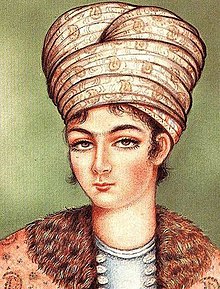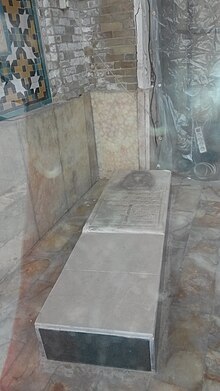Lotf Ali Khan Zand
Lotf Ali Khan Zand (en persan : لطفعلی خان زند / Lotf-'Ali Xân Zand) est le dernier chah de Perse de la dynastie Zand (1769-1794).
Biographie
[modifier | modifier le code]Fils du chah Djafar, il monta sur le trône en 1789, à 20 ans. Il fit face à Agha Mohammad Khan de la tribu Kadjare à partir de 1792. Il est connu pour avoir été "le plus chevaleresque des rois de Perse" selon sir Harford Jones Brydges[1].
Il combat contre ce dernier avec une petite armée, puis il s'échappe jusqu'à la ville de Chiraz et ordonne de fermer les portes.
Lotf Ali perd Chiraz quand son chancelier, Hadji Ibrahim Khan Kalantar (de), le trahit et ouvre les portes de la cité à l'ennemi. Lotf Ali échoue dans sa tentative de s'emparer de Shahr-é Babak et se tourne vers la ville de Kerman.
En 1793, il bat les Kadjars et en 1794, il prend Kerman. Mais il est vite assiégé à Kerman pendant six mois par Agha Mohammad Khan. Quand la ville tombe aux mains d'Agha Mohammad Khan, celui-ci, pris de colère à cause du soutien populaire dont jouissait Lotf Ali Khan, ordonne de tuer ou aveugler tous les habitants mâles de la cité. Une pile de vingt mille globes oculaires est ensuite formée en face d'Agha Mohammad Khan. Les femmes et les enfants sont vendus en tant qu'esclaves et la cité est détruite en quatre-vingt-dix jours[2].
Cependant, Lotf Ali, échappé du siège, est trahi une nouvelle fois, puis capturé près de Bam. Agha Mohammad Khan lui crève les yeux de ses mains et le fait mettre en prison à Téhéran, où il est torturé à mort. Ses femmes et ses filles sont livrées à la soldatesque avant d'être données comme épouses à des domestiques[3].
Sa tombe est dans l'Imamzadeh Zeid, dans le vieux bazar de Téhéran. Son portrait se trouve au Musée des beaux-arts dans le complexe palatial de Saadabad, au nord de Téhéran.

Notes et références
[modifier | modifier le code]- Harford Jones Brydges "An Account of the Transactions of His Majesty’s Mission to the Court of Persia in the Years 1807-11",Londres, James Bohn, 1834|
- Yves Bomati et Houchang Nahavandi, "Les grandes figures de l'Iran", Paris, Perrin, , 392 p. (ISBN 978-2-262-04732-0), voir chapitre consacré à Agha Mohammad Shah
- Prince Ali Kadjar Les Rois oubliés« L'Épopée de la dynastie Kadjare » p. 77-80, Édition no 1 Kian, Paris, 1992 (ISBN 2863913956)
Liens externes
[modifier | modifier le code]
- Notices dans des dictionnaires ou encyclopédies généralistes :
Text is available under the CC BY-SA 4.0 license; additional terms may apply.
Images, videos and audio are available under their respective licenses.


